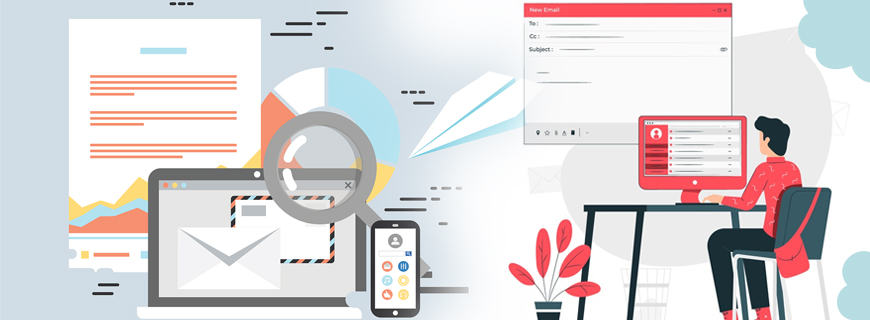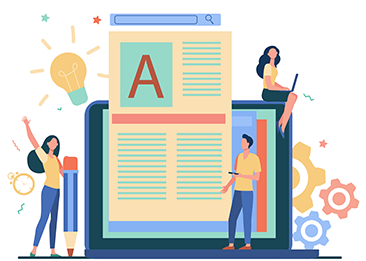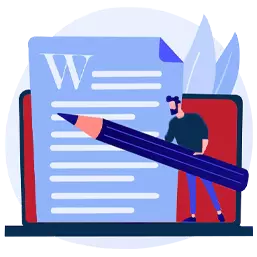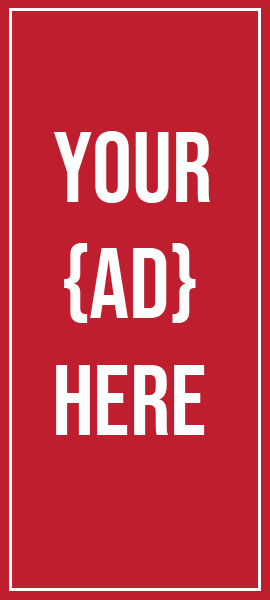
Business E-mails
Almost overnight the internet has gone from a technical wonder to a business must.
– Bill Schrader
Introduction
It would appear that e-mail is the preferred, convenient and effective medium to conduct business communication. It is a form of communication that is rapid, simple, adaptable, and flexible.
In this chapter, you will learn about strategies for using an email that is designed to assist you in improving the efficiency of your communication in the workplace. We will also discuss etiquette guidelines on how to address an email message, as well as grammar and acronyms rules in the letter body.
Addressing Your Message
When addressing an email, it’s important to know the difference among the To, Cc and Bcc fields.
Using the ‘To’ field: The ‘To’ field is used when sending a direct message to someone.
You may send the same email to multiple addresses using the ‘To’ field. Do so when your email is meant to address directly to all recipients, as in the case of a manager directing his team.
Note though that when you use the ‘To’ field, all email addresses can be viewed by all recipients. Put multiple addresses in the ‘To’ field only when every recipient is okay with his or her email address being released to everyone.
Using the ‘Cc’ field: Cc stands for carbon copy.
You use the ‘Cc’ field to send a copy of the email message to people who are not meant to be the direct recipients of the message but still need to be kept in the loop.
For instance, if a manager has ordered his secretary to send a memo to everyone in the department, the secretary may place all the department employees’ email addresses on the ‘To’ section, and the manager’s email addresses on the ‘Cc’ field.
Note that, like the ‘To’ field, all email addresses entered in a ‘Cc’ field can be viewed by everyone.
Using the “Bcc’ field: Bcc stands for Blind carbon copy.
When you place email addresses in the ‘Bcc’ field, recipients are ‘blind’ to other recipients’ email addresses. The use of the ‘Bcc’ field is most appropriate if the recipients have not given permission for their email address to be released, or if there is a reason to keep the email address private.
Because the ‘Bcc’ field offers privacy that the ‘To’ and ‘Cc’ fields do not, you may use the blind carbon copy field for both direct and indirect email messages where privacy of email addresses is needed. If you wish to send an email to many direct recipients, but you don’t wish to disclose anyone’s email address, just use your own email address in the ‘To’ field, and use the ‘Bcc’ field for the recipients’ addresses.
Brief check
Use the “cc” button
Use the “cc:” button for those individuals who need the information, but who would not be required to reply to your e-mail or take any action.
Write a clear subject line
Write the subject lines clearly to let the recipient know what the message is about. What you write in the subject lines should reflect the content of the e-mail.
See the examples below on clear and unclear subject lines.
Example 1
Subject: Seminar (Not Clear)
Subject: Security Management Seminar held by Siemens (Clear)
Example 2
Subject: Photocopy Machine (Not Clear)
Subject: Authorisation for Photocopy Machine Purchase (Clear)
Example 3
Subject: Information (Not Clear)
Subject: Request for Salary Information (Clear)
From:[email protected]
CC:[email protected], [email protected]
Subject:Safety Training Modules Presentation
Adam,Please be prepared to make a ten-minute presentation on “Safety Training Modules” to all employees on June 15, 20xx, at 10.a.m. in the conference room.
Regard,Jassim Mann Safety Manager
In this e-mail Mr. Jassim requests Adam to deliver a presentation and he sends copies to James and Lila for their information only.
- “To” is expected to respond.
- “CC” is expected to read the message as information only.
Use attachments for long documents
Since not all computers have the same type of software, you should inform readers which program or software is needed to open your attachment.
It is best to inform your readers of the format of any attachments you send if they’re anything other than basic Microsoft Office file types.
- Before sending an attachment, consider whether your reader has the software to open and view the file.
- Be careful of file sizes; use zip files for extra-large attachments.


Keep your message short and don’t use e-mail for immediate action
E-mail is meant to be brief. Keep your message short and to the point. Use only a few paragraphs and a few sentences per paragraph.
Don’t use e-mail if you need an immediate reply or action. Remember that the person you are sending the e-mail to may be in a meeting, out of the office, or taking leave or absent. For any of these reasons, they may not be able to reply to you immediately.
For immediate responses use another, more personally direct means of communication such as mobile or telephone.
Brief check
E-mail is a great way to quickly get information to many people, but may not be the right answer for all communications.
Grammar and Acronyms
While online mediums of communication have developed their own vocabulary, it’s best to remember that business emails have the same formality as any business letter.
Here are some key things to remember with regards to grammar and the use of acronyms in an email.

- Always follow the rules of good grammar. You may refer to English writing style guides for these rules.
- Always use full sentences and words with proper sentence structure. Don’t use text-speak.
Example: use “The reports are due on Monday.” instead of “D reports r due Mon”
- Proper capitalization and punctuation are a must! In the email, all caps give the impression that you’re shouting, and small caps are hard to read. Example: use “The report should include an evaluation report.” Instead of “The report SHOULD INCLUDE AN EVALUATION REPORT.
- In business emails, avoid text-speak abbreviations such as BTW (by the way), IMHO (In my honest opinion,) and LOL (laugh out loud). Avoid the use of emoticons, as well.
Use respectful language
Please take a moment to read the e-mail that follows and think about how you would react if you were the reader. After that, contrast it with the amended email that was written in a manner that is respectful.
In order for business e-mails to be effective, please consider the top ten tips before you hit the Send button:
- Keep your message short.
- Make your subject line mean something.
- Start your e-mail with Dear and end with a simple closing (Thanks or Regards).
- Always spell words correctly!
- Write in a positive tone.
- Sign your messages with at least your name, job title and contact number.
- Don’t use only capital letters.
- Don’t just rely on an e-mail. An e-mail can be lost. Follow-ups can often be done via the telephone or regular mail.
- Avoid using abbreviations unless your readers are familiar with their meaning.
- Tell people the format of any attachments you send if they’re anything other than basic Microsoft Office file types.
Practical Application
Victoria intended to compose two different emails. The other copy was going to be delivered to her partner, and it was going to be read by everyone on their team. The second email would be sent to all of the members of the department, but the information it included was only pertinent to select members of the group; yet, it was important for everyone to remain up to speed.
On the very first one, she filled in the ‘To’ field. This ensured that it would be distributed to everyone and that everyone would be aware that it was intended specifically for them. The second was distributed to all of the participants, although the information was only necessary for the partner.
The remainder of the people involved in the project were sent the email so that they may remain informed and updated regarding the status of the project.





